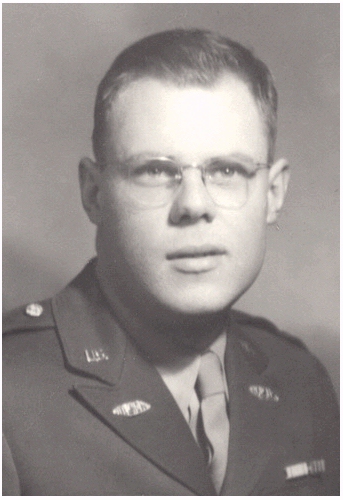
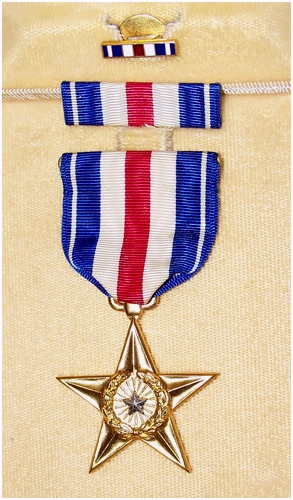
Lt. Wrolson and his Silver Star Medal (for his action on Sept. 20, 1944)
General George Patton was furious on Field Marshal Bernard Montgomery his slow progress and the claim
he laid on the supplies. General Bradley was
willing to cut Patton some slack. But the supreme commander, Eisenhower,
was torn between the northern attack by Montgomery, and the eastern attack by
Patton's Third Army. Eisenhower wanted as fast as Montgommery could to move up to Berlin
and Hamburg and further to Danmark. But a broad front was also a strategic
good plan, it would keep the Germans spread over a large area. So, Montgomery
would have the first say over supplies, and Patton got the order on September 12,
1944 to go over the Moselle river by the end of Thursday September 14. If he would
not manage this, then he had to take up defensive positions from Nancy towards
Luxembourg. Eisenhower trusted Patton that if he would cross the Moselle, Patton
would make bridgeheads and wait for orders, until US First Army and British
Second Army in the north broke out towards the Rhine, than Eisenhower would unleash
Third Army.
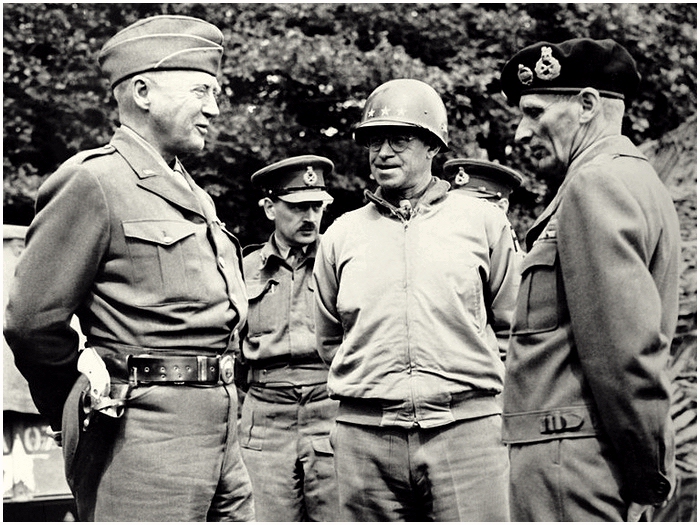
Left, Patton, and the man in the
middle of it; General Bradley, and Montgomery
Eisenhower was not only busy with strategics, but also politics were of
his main concerns, if he would not cut Montgomery some slack, Churchill would be on his neck,
just as President Roosevelt. He didn't get along, just as Patton did, with the stubborn Montgomery who
thought of himself a great leader and strategist. So a letter was written by Eisenhower
to explain why Monty was given priority over Patton, the harbors, such as Antwerp and
Rotterdam had to be taken to bring in supplies. And the V1 and V2 weapons, launched
from Holland had to be destroyed. But if these subjectives were taken, then Patton could
carry on with offensive actions. Eisenhower had not only Patton, Montgomery and Bradley to
please, there was also a southern offensive going on, he had the French army to consider,
etc. In total, Eisenhower had 2.2 million soldiers in Europe, divided in 50 divisions, 23 American
divisions, 17 British divsions, and Canadian, Polish and French divisions.
Hitler was aware of Patton’s army, and knew his reputation. Field Marshal Gert von Rundstedt,
Commander in Chief West, had two army groups, Army Group B under command of Field Marshal
Model, and Army Group G under command by General Blaskowitz (and later General Balck). Von
Rundstedt could bring just 750.000 men together for the defense in the West. But they would
operate in familiar terrain and they would defend there 'Heimat' (home country).
Patton organized his Third Army into two Corps. IIth Corps in the north with the 5th, 83rd
and 90th Infantry Divisions, and IIIth Corps in the south commanded by Major General Manton
S. Eddy. IIIth Corps consisted of the 80th Mechanized Infantry Division, 35th Infantry Division,
the 4th and 6th Armored Divisions and the 2nd Cavalry Group. And so Patton’s 4th Armored Division
stood across elements of the First German Army, two divisions and three Panzer Brigades, of the
Fifth Panzer Army (with some 75 PzKpfw IV and 107 PzKpfw V, Panther tanks, 126 2cm guns and 190
artillery guns and 13.700 men).
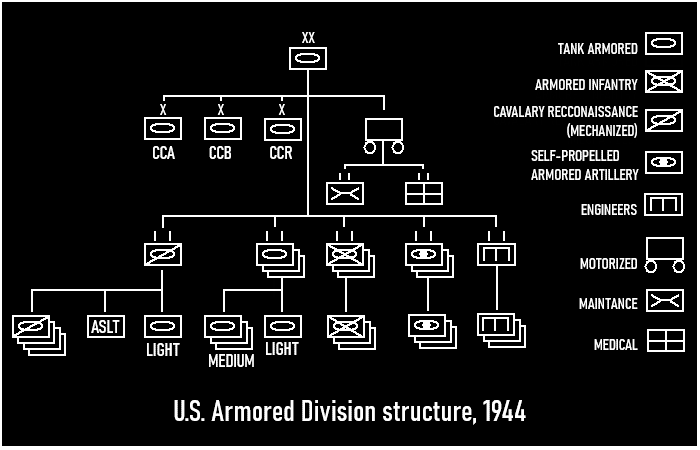
An US armored divsion consisted, on paper, of three tank battalions, with a total of 2,187 men,
(729 men per battalion), 186 Medium tanks, and 77 Light tanks in a division.
Each battalion had three Medium tank companies with 17 tanks and one Light tank company.
As support,
the divison had three armored infantry
battalions (over 3000 men), three self propelled field artillery battalions (1,623 men and 54 guns)
and a cavalry reconnaissance squadron.
Attachments could consist of anti-aircraft machineguns, tankdestroyers, and engineers and even more
tank battalions. A total of 15.700 men were attached to the 4th Armored Division. And to keep this
division moving, it had to have fuel. Because Monty his army was given the most of the fuel, Patton
used all his imagination. Most vehicles not neccesary for battle would be given no fuel. Captured
German fuel was used and even officers from Patton’s army went to the fuel dumps of Hodges First
Army and posted themself as officers of the First Army to get to the fuel. Combat Command Alfa
spearheading the attack across the Moselle towards Sarreguemines would benefit the most of the
extra fuel distribution.
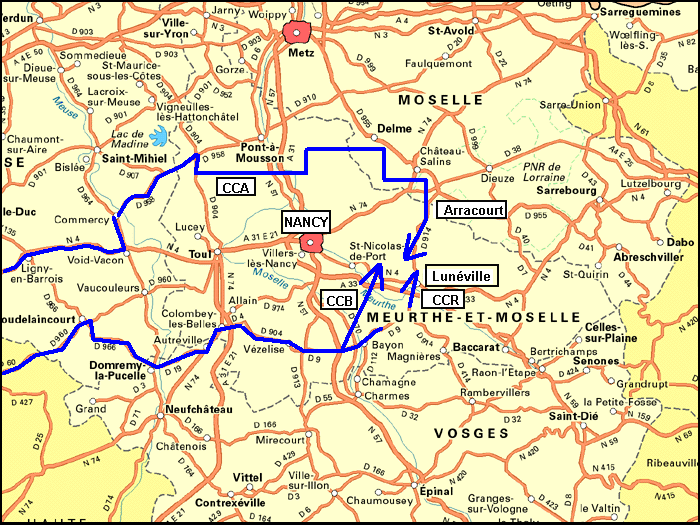
The global routes of the CCA, CCB and CCR of the 4th AD. around Nancy
General Woods was not happy with the plans
on how to capture Nancy, and decided that just CCB would attack from the south, and to held CCA in reserve. But
CCA would eventualy go over the north of Nancy, so the two Combat Command teams would meet east of the city.
To back up the CCB, CCR would be close behind for support. On September 13, 1944, the M4 tanks of the 37th knifed across the Moselle River and,
on the 14th overran the rear command post of the German 15th Panzer Grenadier Division
at Arracourt and, in Valhey, caught the same division's forward echelon command post before
it could displace rearward. And so, Nancy was encircled on the same day and the city fell the next day, september 15.
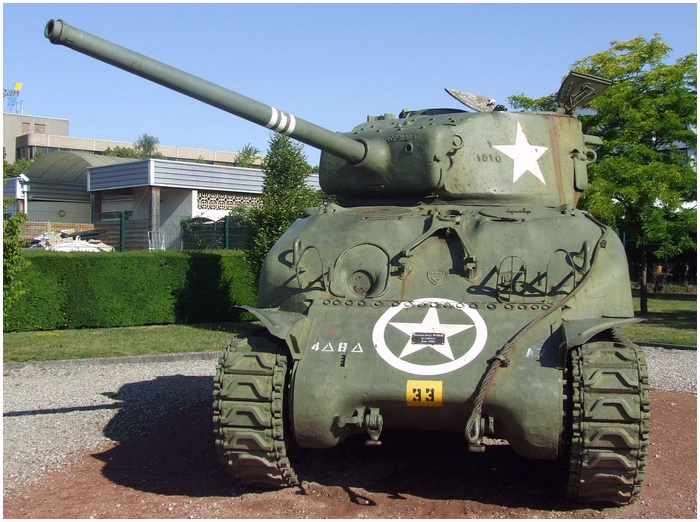
This M4A1(76)W Sherman can be found in Nancy,
dedicated to the 4th Armored Division
(Avenue De Résistance, near the Novotel hotel)
The fiercest fight came on the four days of September 19-22. The
Germans counterattacked in heavy fog and rain with 56 Mark V Panther tanks and attempted to
overrun HQ of the 37th Tank Battalion defended by C Company's tanks near the town of Lezey.
On September 20, some of Lt. Wrolson's tanks were bogged down in the muddy fields and under
German attack. He personally went out under heavy fire and with the help of chains and his tank,
freed the stuck tanks. For this action he was awarded the Silver Star for gallantry in action
against the enemy and on October 9 1944 Walter was promoted to 1st Leutenant.
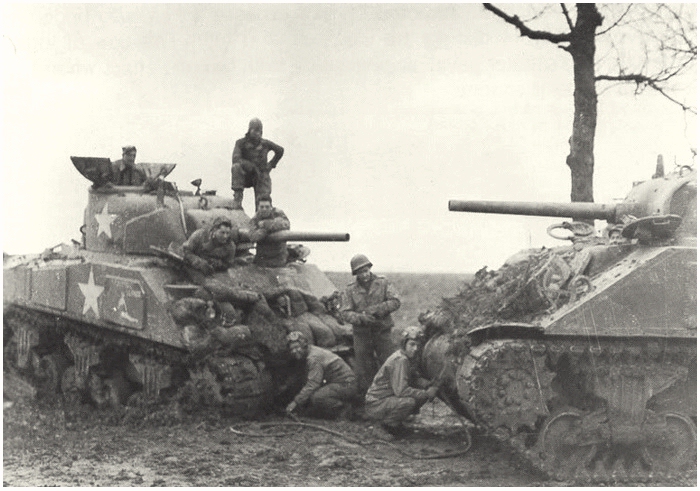
In such a way, Lt. Wrolson pulled out bogged down tanks
(6th Armored Division M4 Sherman tanks in the same area)
In this region the largest tank battles were fought by the US Army during World War II. The
4th Armored Division was thrown into battle as a virgin fighting unit, but came up trumps. It was
tops in attack, but also in defending and pursue the fleeing enemy. 37th Tank Battalion destroyed during
the four days of fighting, between September 19 and 22, 55 Panther tanks, many factory fresh, and lost 14 tanks itself.
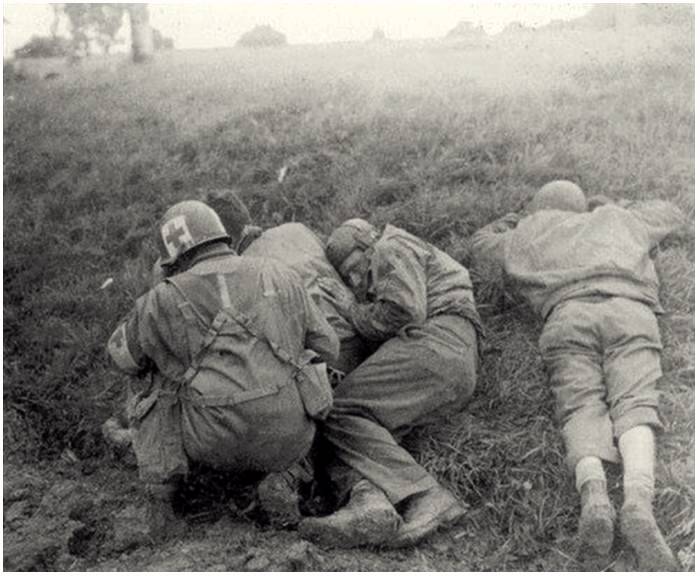
After their vehicle was put out of action during the battle at Arracourt,
this crew seeks shelter. One member is getting treatment by an US Army medic
On November 6, General Patton visited the division. He was quoted as saying "The accomplishments
of this division have never been equaled. And by that statement, I do not mean in this war, I mean
in the entire history of warfare. There has never been such a superb fighting organization
as the 4th Armored Division".
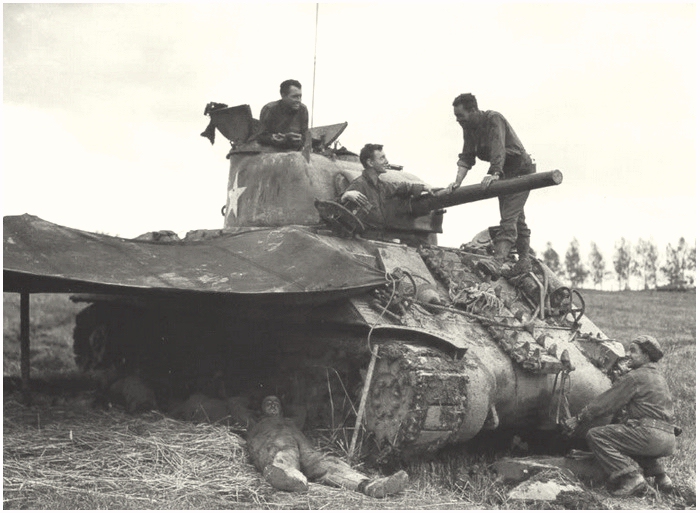
An M4 Sherman of 37th Tank Battalion, 4th Armored Division
ready for the
night after a day of fighting near Chateau Salinas
On November 9, the 37th Battalion moved out of Arracourt and attacked in a column as wide as the road
they drove on. It was cold, wet and slow going. During this time a notable Sherman tank was mentioned
in the after action reports for the first time,... an M4A3E2 with the name 'Cobra King'.
'Cobra King' would become famous as 'the first tank is Bastogne'
(more on this on the coming pages). On November 9 Captain Richard Lamison was commanding 'Cobra King' during attack outside Fonteny.
The struggle through the mud slowed down the tanks, and were easy targets for the enemy. 'Cobra King' was hit on the
rightside and was disabled.
After Action Report: Just after crossing the ridge the final drive of Capt Lamison's tank was hit, stalling
the tank (the crew escaped). Capt Lamison then, via radio, turned the company over to Lt. Walter W. Wrolson. Lt. Wrolson
moved the tanks down into the valley between the two ridge lines which prohibited the enemy in the woods on his flank from firing
into the tanks. Neither could they be reached by fire from the enemy tanks from the edge of town. This was not true, however,
of the enemy installations to the northeast of Fonteny. They continued to fire on the tanks. C/37 answered the fire and knocked out two
or three enemy tanks, but the heavy AA could not be silenced even though HE was fired into the area.
When darkness fell, and the ammunition was expended, the tanks retreated under a smokescreen. Two more tanks were knocked out,
and the remaining tanks bogged dowd. Under constand enemy fire the crews worked to free the vehicles,
but around 21.00 hours the crews abandoned their tanks.
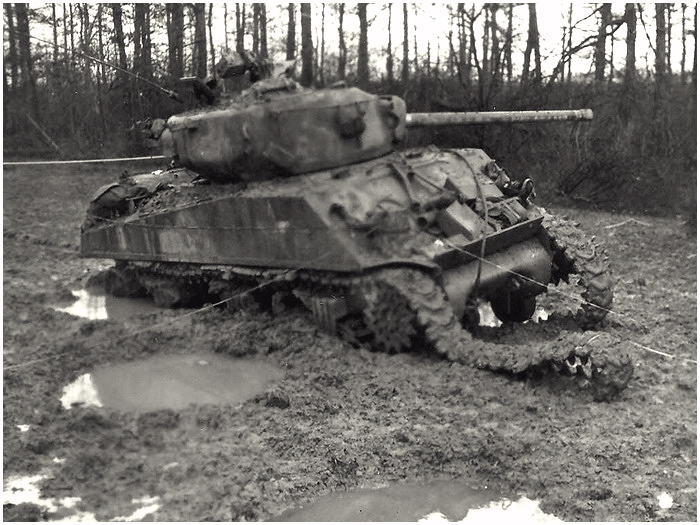
November 1944, an M4A3(76) bogged down after losing his tracks
(This is a 6th AD Sherman, but gives a good example of the conditions)
The next day, November 10, 35th Infantry Division attacked Fonteny which
was entered around midnight. On November 11 the bogged down tanks were recovered (among them 'Cobra King').
During the attack of C/37, four tanks were lost, and three men killed. Six men were injured, but five of them
returend later back at their company.
In late November,
the battalion crossed the Saar River. On December 3, General John Shirley Wood, commander of the 4th Armored Division,
was replaced by Major General Hugh J. Gaffey. General Manton S. Eddy, a general who could not get along
with Wood, complained with Patton, who relieved Wood from his duties.
On December 8 the 37th smashed through the old French Maginot Line
and took Singling. On December 16 the battalion's vehicles were the first 4th Armored Division vehicles to
enter Germany when they chased several German tanks into the woods near Rimling.
DECEMBER 16, START OF THE 'BATTLE OF THE BULGE'
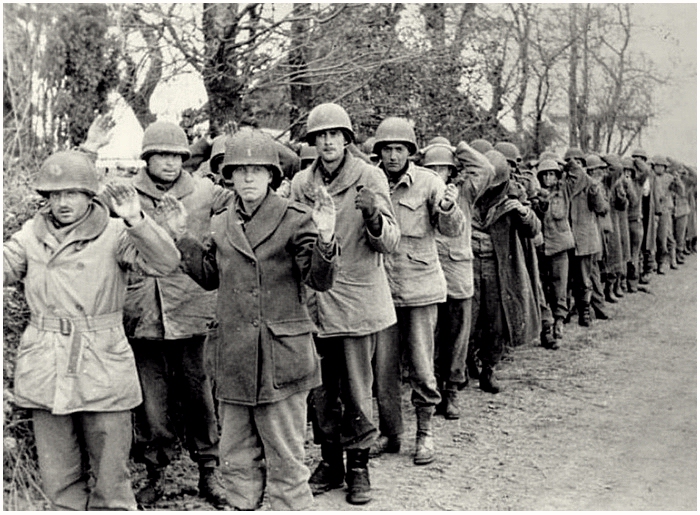
American GI's surrender to the overwhelming power of the German troops
But December 16, 1944 was also another memorable day, for both sides, when the Germans came into
action for Operation ‘Wacht am Rhein’, the beginning of ‘The Battle of the Bulge’. When Patton was
notified he was sure this was not just some small German attack, but a serious attempt to drive a
wedge into the Allied armies. Eisenhower went to Verdun on December 19 to have a meeting with Air
Marshall Tedder, General Bradley, Lt. Gen. Jacob Devers, General Patton, and deputy of Montgomery,
Freddie de Guingand (Monty would not bother to sit round a table with ranks lowers than his). Patton
thought that letting the ‘Sons of Bitches getting all the way to Paris, then they would really cut
them up and chew’em up’. There was laughter around the table, but Eisenhower cut Patton short by
saying that he refused the Germans across the Meuse. He wanted that Patton move six divisions as
soon as possible to the north. Patton told that he had only three, the other were only on paper,
the losses at the Hürtgen Forrest were still not refitted, and only the 4th Armored, the 26th and
80th Infantry Divisions were available. But he promised he could move out at any day, just a call
to Nancy where Maj. Gen. Hobart Gay was waiting orders with three plans Patton had suggested, and
the show would be on the road. The other men around the table were skeptical and raised worries.
Tens of thousands of men and vehicles and equipment had to reverse from the east and move north,
to Bastogne.
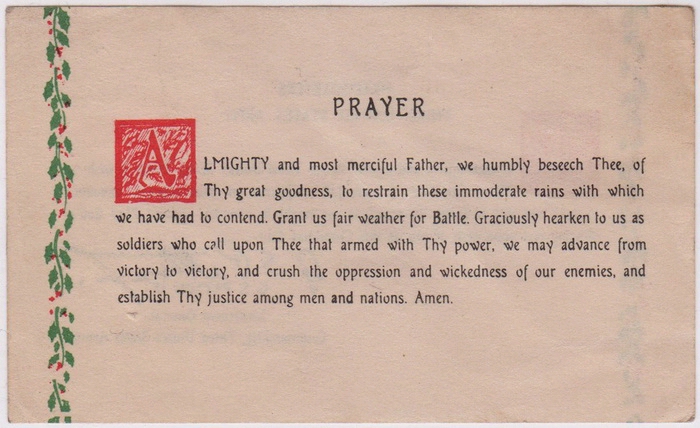
The 'prayer for good weather' (click on picture for the reverse side)
Just 125 miles from Bastogne, but it was very far, the weather was terrible, snow
and slippery roads, bridges were destroyed, roads mined. Patton asked army chaplain Col. James
O’Neil to write a prayer for good weather that would be printed on a small card and distributed among the
men in the Third Army. On the reverse side of the card, Patton wrote a personal message
for his officers and soldiers to wish them a Merry Christmas. The prayer was printed on 250.000 small cards and
distributed. And low and behold, the weather turned, the sky cleared and planes
could fly, and vehicles found firmer ground (chaplain O'Neil was later granted by Patton himself the Bronze Star).
A LITTLE KNOWN FACT,...
The first troops from the 4th Armored Division to reach Bastogne were
tanks from 8th Battalion, CCB. At 10:45 a.m.
on December 18, CCB was placed on a one-hour alert.
This was canceled, but at 11.00 p.m. a new order came in,…
not moving east but to change course to the north!
The 8th Tank Battalion crossed the IP at 12:50 a.m. on December 19.
They had no information about the situation up ahead or about the enemy.
CCB’s orders were to move to an area in the
vicinity of Longwy, France. Leading the column was
Lt. Col. Albin F. Irzyk, who was totaly in the dark, he had no map,
the only map was with his commanding officer, Brig. Gen. Holmes E. Dager,
who radioed the directions.
Nine hours after CCB was CCA to follow the same route.
When they reached Longwy they were sent through,
passed Arlon, into Belgium, towards Neufchâteau. At Vaux-les-Rosières the column
halted at 11.00 p.m. for the night.
The tanks had made a journey 161 miles in 22 hours, most at night.
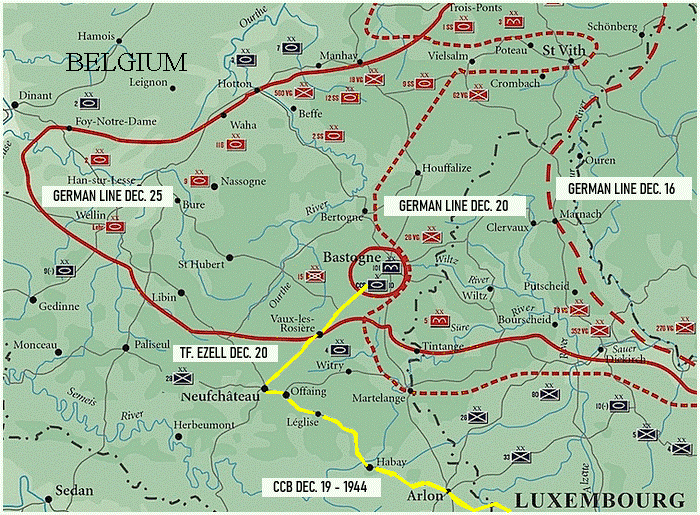
On the map the route of CCB on December 19 and the Task Force Ezell on Dec. 20
Next morning, December 20, General Dager called Lt. Col. Albin F. Irzyk
and gave him the order to send
a task force into Bastogne. Irzik protested because he did not know
how the situation was up the road.
Dager agreed and had himself protested against this order by Maj. Gen. Troy H.
Middleton of the VIII Corps
(who wanted the whole of CCB). Dager wanted to wait for the whole of 4th AD.
But instead of sending CCB
into Bastogne, a task force would go instead. And so, A Company,
8th Tank Battalion; C Company, 10th
Armored Infantry Battalion; and C Battery, 22nd Armored Field Artillery Battalion, all under command of
Captain Bert P. Ezell. And thus, “Task Force Ezell” moved out, towards Bastogne. In Bastogne, Ezell
should make contact with Brig. Gen. Anthony C. McAuliffe, commander of the 101st Airborne Division,
who could give instructions and to give him support if so ordered. But when the task force arrived
in Bastogne, Colonel William Roberts, commander of Combat Command B of the 10th Armored Division was
waiting for Ezell. When Col. Roberts was given instructions, the order came from divisional headquarters
that Ezell was immediately to return his force back to Nives. A disappointed Roberts saw the task force
mount up again and turn back the way they just had come of. Seven hours after they left, the task force
returned. They had more vehicles with them than when they left the bivouac.
On the way back, they came
across many abandoned US vehicles and artillery in good condition,
but not a GI in sight. On the way in to Bastogne the vehicles were not there. So,
in the few hours Ezell was in Bastogne, other troops of US army had crossed the
same road, but so were German troops. And they had apparently overrun the American
troops, but had not stopped to check the American vehicles. So, some of these
vehicles were now brought back to there own lines.
The 8th Tank Battalion was ordered to retrace its steps of the previous
night and move southwest to Neufchâteau, then southeast to Léglise.
Here they learned that the remanining of the 4th Armorde Division were still around Arlon.
After some rest, the 80th and 26th Infantry divisions and the
4th Armored Division (on the left flank) moved out on December 22, towards
the now completely encircled Bastogne.
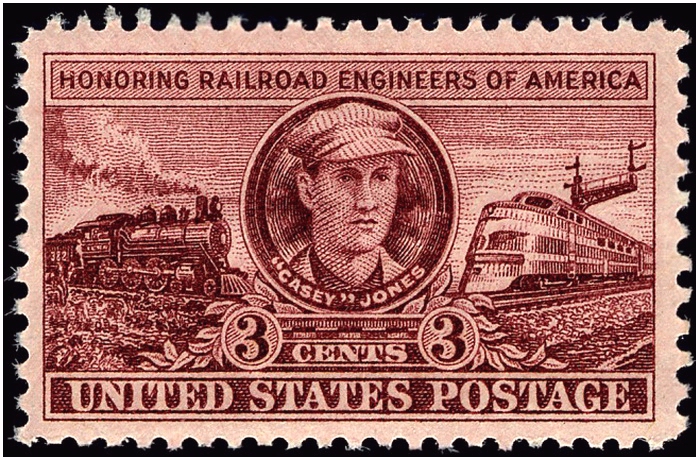
Casey Jones, a Legend,...
We reach now the action where Walt Wrolson would enter history. But before we drive with
him towards Bastogne, I like to give some more details on the unit he was in and the tank
he was commanding. Walt entered the war in a M4 Sherman tank, which was named after a
legendary railway man, Casey Jones. Jonathon Luther 'Casey' Jones, born in 1863 in Jackson,
Tennessee, and was working for the Illinois Central Railroad in 1900.
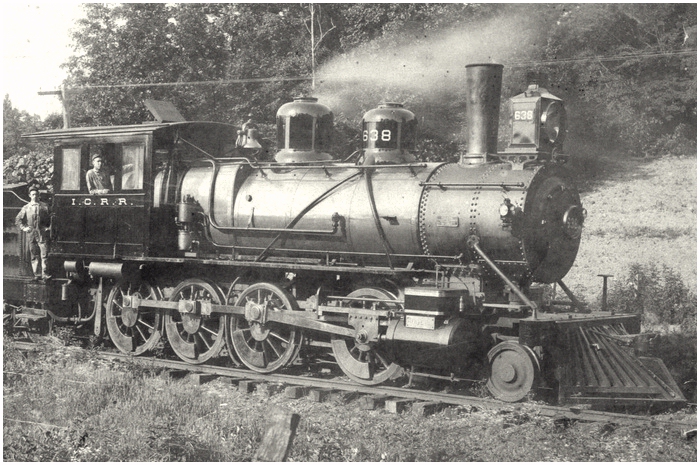
Casey Jones leaning out of the window from his locomotive
On April 30, 1900, Casey Jones
was driving locomotive No. 1 together with Sim Webb, the fireman. Despite the train departed
75 minutes behind schedule from Memphis, No. 1 was a fast engine, and with speeds up to 80
miles per hour, they had won 55 minutes from the 75 minute delay when they reached Grenada,
Mississippi. Another 15 minutes were made up towards Winona, Mississppi, and they were almost
back on schedule when the train reached Durant, Mississippi. With new orders to move the train
to Goodman, Mississippi, they departed Durant. Unknown to Casey, three trains were at the station
of Vaughan. No. 38 and No. 72 were on the passing track, with some cars, because of the length,
standing still on the main track. Also on the track was No. 26. To rearrange all these trains
it took some time to make the maneuvers. Railway workers moved some of the cars of the No.83
with No. 72 on the main track, the same track Jones was on. Suddenly an airhose broke from No.
72 and locked the brakes. With four cars of No. 83 on the main track a disaster was in the making.
Sim Webb was the first who saw the red glow of a light from the last car. He yelled a warning
to Casey Jones, who screamed back at Web to jump the train. Web jumped, and Jones slammed the
airbrakes and throttled back. But to no avail, the train crashed into the parked cars, and
Jones was killed instantly. There were no other casualties, only some slight wounded, thanks
to the heroic deed by Jones, to stay with his train and trying to slow it down. And the
legend was born. A song, The Ballad of Casey Jones, was made popular by singer Bill
Murray, Pete Seeger, and Johnny Cash among others. Many other songs and artists have recorded
songs with Casey Jones as a motive, sometimes by name, sometimes with a reference to Jones,
as in Ridin with the driver by Motorhead.
In 1927 a movie was released staring Ralph Lewis as Casey Jones. And also a television
series, loosely based on the Jones legend, was running during the late fifties.
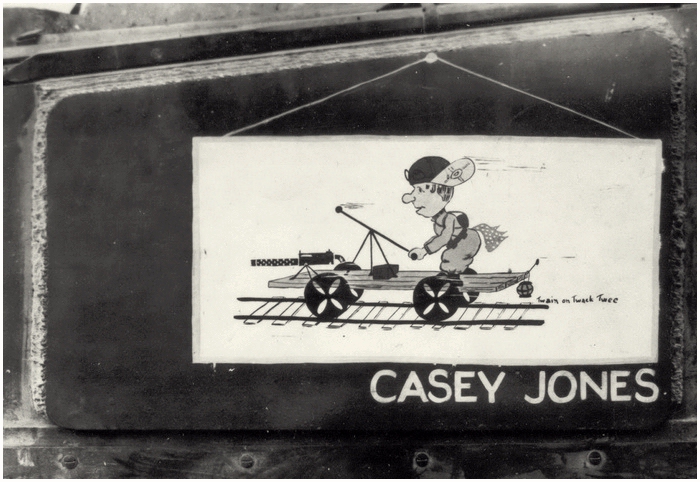
An unknown artist made the cartoon on Walt his M4 Sherman
But Casey Jones was also remembered by the crew of the Sherman tank Walt Wrolson
was commanding. Who suggested the name and made the cartoon is lost in history. There is
some small writing on the cartoon, 'Twain on Twack Twee'.
Tanks were named beginning
with the first letter of the company they were serving in. For instance, the M4A3(76)W
Sherman tank driven by Captain James H. Leach during the Bastogne siege lifting was called
'Block Buster', because he was in Company B, of 37th Battalion. In Company C, of 37th
Battalion, was one tank that would probably become one of the most famous tanks of the
Second World War, 'Cobra King', the M4A3E2 Jumbo tank, commanded by Lt. Charles Boggess.
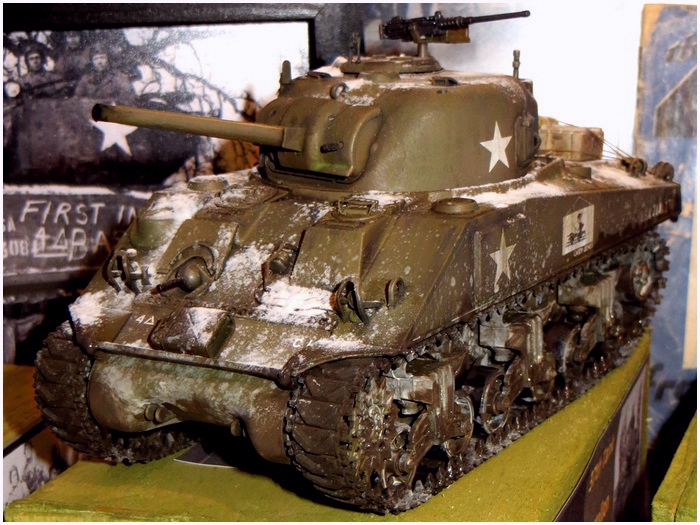
A very fine model of Walt his M4 Sherman was made by Erwin Verholen
(Walt made the rush towards Bastogne in a later type, an M4A3(75)W)
Ballade of Casey Jones
Come all you rounders if you want to hear
A story 'bout a brave engineer,
Casey Jones was the rounder's name
'Twas on the Illinois Central that he won his fame.
Casey Jones, he loved a locomotive.
Casey Jones, a mighty man was he.
Casey Jones run his final locomotive
With the Cannonball Special on the old I.C.
Casey pulled into Memphis on Number Four,
The engine foreman met him at the roundhouse door;
Said, "Joe Lewis won't be able to make his run
So you'll have to double out on Number One."
If I can have Sim Webb, my fireman, my engine 382,
Although I'm tired and weary, I'll take her through.
Put on my whistle that come in today
Cause I mean to keep her wailing as we ride and pray.
Casey Jones, mounted the cabin,
Casey Jones, with the orders in his hand.
Casey Jones, he mounted the cabin,
Started on his farewell Journey to the Promised Land.
They pulled out of Memphis nearly two hours late,
Soon they were speeding at a terrible rate.
And the people knew by the whistle's moan.
That the man at the throttle was Casey Jones.
|
Need more coal there, fireman Sim,
Open that door and heave it in.
Give that shovel all you got
And we'll reach Canton on the dot
On April 30, 1900, that rainy morn,
Down in Mississippi near the town of Vaughan,
Sped the Cannonball Special only two minutes late
Traveling 70 miles an hour when they saw a freight.
The caboose number 83 was on the main line,
Casey's last words were "Jump, Sim, while you have the time."
At 3:52 that morning came the fareful end,
Casey took his farewell trip to the promised land.
Casey Jones, he died at the throttle,
With the whistle in his hand.
Casey Jones, he died at the throttle,
But we'll all see Casey in the promised land.
His wife and three children were left to mourn
The tragic death of Casey on that April morn.
May God through His goodness keep them by His grace
Till they all meet together in that heavenly place.
Casey's body lies buried in Jackson, Tennessee
Close beside the tracks of the old I.C.
May his spirit live forever throughout the land
As the greatest of all heroes of a railroad man.
Casey Jones, he died at the throttle,
With the whistle in his hand.
Casey Jones, he died at the throttle,
But we'll all see Casey in the promised land.
|
Written by Wallace Saunders |
Lyrics Provided by
http://www.trainweb.org/caseyjones/song.html: |
|
|
For the next chapter,...
Click on the M4 Sherman below
with a recreation of 'Casey Jones'
(notice how 'Casey Jones' was placed, he is driving backwards)
|